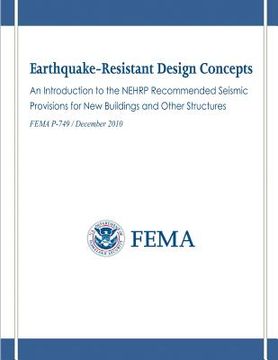Compartir
Earthquake-Resistant Design Concepts: An Introduction to the NEHRP Recommended Seismic Provisions for New Buildings and Other Structures (FEMA P-749 / (en Inglés)
U. S. Department of Homeland Security
(Autor)
·
National Institu Seismic Safety Council
(Autor)
·
Federal Eme Agency
(Autor)
·
Createspace Independent Publishing Platform
· Tapa Blanda
Earthquake-Resistant Design Concepts: An Introduction to the NEHRP Recommended Seismic Provisions for New Buildings and Other Structures (FEMA P-749 / (en Inglés) - Security, U. S. Department of Homeland ; Seismic Safety Council, National Institu ; Agency, Federal Eme
$ 612.16
$ 1,020.26
Ahorras: $ 408.10
Elige la lista en la que quieres agregar tu producto o crea una nueva lista
✓ Producto agregado correctamente a la lista de deseos.
Ir a Mis Listas
Origen: Estados Unidos
(Costos de importación incluídos en el precio)
Se enviará desde nuestra bodega entre el
Lunes 12 de Agosto y el
Viernes 23 de Agosto.
Lo recibirás en cualquier lugar de México entre 1 y 3 días hábiles luego del envío.
Reseña del libro "Earthquake-Resistant Design Concepts: An Introduction to the NEHRP Recommended Seismic Provisions for New Buildings and Other Structures (FEMA P-749 / (en Inglés)"
Of the 500,000 or so detectable earthquakes that occur on Planet Earth each year, people will "feel" about 100,000 of them and about 100 will cause damage. Although most earthquakes are moderate in size and destructive potential, a severe earthquake occasionally strikes a community that is not adequately prepared and thousands of lives and billions of dollars in economic investment are lost. For example, a great earthquake and the fires it initiated destroyed much of San Francisco in 1906 and a significant portion of Anchorage, Alaska, was destroyed by a large earthquake in 1964. Within the past 200 years, major destructive earthquakes also occurred in Charleston, South Carolina, and Memphis, Tennessee. Within the past 50 years, smaller but damaging earthquakes occurred several times in both Los Angeles and Seattle. Overall, more than 20 states have a moderate or high risk of experiencing damaging earthquakes. Earthquakes are truly a national problem. One of the key ways a community protects itself from potential earthquake disasters is by adopting and enforcing a building code with appropriate seismic design and construction standards. The seismic requirements in U.S. model building codes and standards are updated through the volunteer efforts of design professionals and construction industry representatives under a process sponsored by the Federal Emergency Management Agency (FEMA) and administered by the Building Seismic Safety Council (BSSC). At regular intervals, the BSSC develops and FEMA publishes the NEHRP (National Earthquake Hazards Reduction Program) Recommended Seismic Provisions for New Buildings and Other Structures (referred to in this publication as the NEHRP Recommended Seismic Provisions or simply the Provisions). The Provisions serves as a resource used by the codes and standards development organizations as they formulate sound seismic-resistant design and construction requirements. The Provisions also provides design professionals, building officials, and educators with in-depth commentary on the intent and preferred application of the seismic regulations. The 2009 edition of the Provisions (FEMA P-750) and the building codes and consensus standards based on its recommendations are, of necessity, highly technical documents intended primarily for use by design professionals and others who have specialized technical training. This introduction to the NEHRP Recommended Seismic Provisions is intended to provide these interested individuals with a readily understandable explanation of the intent of the earthquake-resistant design and requirements of the Provisions. Chapter 1 explains the history and purpose of building regulation in the United States, including the process used to develop and adopt the nation's building codes and the seismic requirements in these codes. Chapter 2 is an overview of the performance intent of the Provisions. Among the topics addressed are the national seismic hazard maps developed by the U.S. Geological Survey (USGS); the seismic design maps adopted by the Provisions as a basis for seismic design; and seismic risk, which is a function of both the probability that a community will experience intense earthquake ground shaking and the probability that building construction will suffer significant damage because of this ground motion. Chapter 3 identifies the design and construction features of buildings and other structures that are important to good seismic performance. Chapter 4 describes the various types of structures and nonstructural components addressed by the Provisions. Chapter 5 is an overview of the design procedures contained in the Provisions. Chapter 6 addresses how the practice of earthquake-resistant design is likely to evolve in the future. A glossary of key technical terms, lists of notations and acronyms used in this report, and a selected bibliography identifying references that may be of interest to some readers complete this report.

